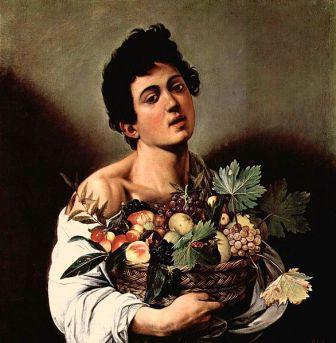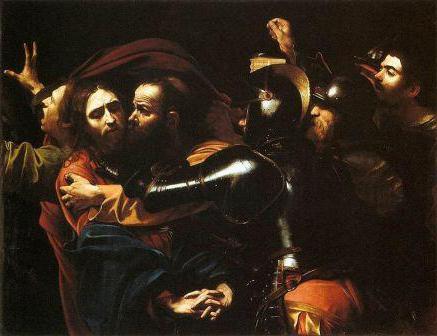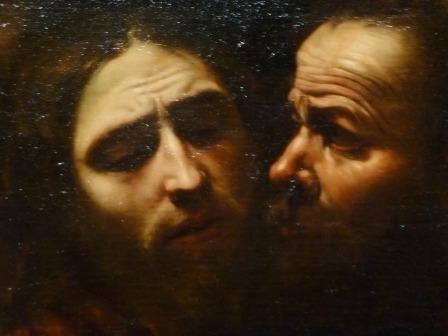Michelangelo Caravaggio is an artist of the Baroque era. His skill in operating with light and casting shadows, as well as maximum realism in combination with the tragic expression of the characters bring the master to the fore. Caravaggio gained recognition during his lifetime. The popular artist was invited to paint the paintings by the rich and powerful families of Italy. He had his students and followers trying to paint in the same manner. They are called "Karavagists." Such inheritance gave rise to a large number of supposedly “copyright copies”. And the picture “Kiss of Judah” is no exception. One of them had an interesting story in Odessa. Read about it, as well as about the original canvas in this article.
Theme of Christ's custody
In the Middle Ages, frescoes and church murals were the "Bible for the illiterate." But about the last days of Christ, the descriptions of the gospels diverge. John claims that Jesus himself went out to meet the armed detachment and asked: "Who are you looking for?" And when He called himself, those who came to arrest him “fell to the earth” (Jo 18: 6). The other three evangelists tell a completely different story. A detachment of soldiers brought Judah to the Gethsemane . There were no documents with photographs then, and Christ outwardly looked like James the Younger (in the Gospels he is also called the brother of Jesus). Therefore, the agreement was this: whoever Judas kisses, he must be arrested. This theme of betrayal has been addressed by many artists, starting with Giotto. The fresco of this master in Padua became a Christomatism example. Thus a tradition arose to portray Judas always in profile and with a black halo. But the picture of Caravaggio makes us take a different look at the events that happened two thousand years ago.

Writing history
Around 1602, the aristocratic Roman clan Mattei invited a fashionable artist at that time. The family owned a small art gallery. Negotians wanted at all costs to get the creation of a popular master. Caravaggio settled in the Mattei Palace and received a deposit for his work. The theme for the picture, presumably, was ordered by one of the members of the surname - Cardinal Girolamo. And it was written in record time - in just thirty days. But the master received an unprecedented fee for the work - one hundred twenty-five scarcely. Caravaggio's “Kiss of Judah” has long been a jewel in the Mattei family gathering. It is known that the master made his own copies of his successful work. In addition, his school students echoed him. Now there are twelve paintings repeating the original.
The composition of the canvas "Kiss of Judah"
Caravaggio's painting is painted on an elongated canvas. The artist’s innovation is manifested in the fact that the figures of people are depicted not in full growth, but in three quarters. Caravaggio remains true to himself in the game with the light. The main radiance comes from a source invisible to the viewer, which is located in the upper left corner. But there is less light - a lantern that the young man holds on the right. Two sources, echoing each other in the night darkness, give the whole action a special tragedy. One arm of Judah is somewhat shortened. It immediately catches the eye, as the rest of the figures are made with amazing realism. Lack of artist skill? Art historians believe that this is a conscious step. So the artist wanted to show the moral ugliness of a man who raised his hand to his Master. Therefore, the painting is called not “Taking Christ into custody,” but “The Kiss of Judah.” Caravaggio's painting focuses on the topic of betrayal. The last days of Jesus are fading into the background.
Caravaggio painting: lost and regained

The Mattei family owned the canvas for about two hundred years. Over time, fashion changed, brutal realism and a whirlwind of baroque passions gave way to idealistic, copying antiquity compositions of the era of classicism. Caravaggio's painting has lost authorship in the documents of the Mattei family. When the descendants of this kind began to experience financial difficulties, they decided to sell this canvas. The painting was bought by a member of the English parliament Hamilton Nizbet as a work of the Dutch artist Gerard van Honthorst. In 1921, the last representative of this Scottish family died, and the canvas under the same authorship was bought at auction by John Kemp. He resold it to the Irish Maria Lee-Wilson, who in 1934 presented a picture of the Jesuit Consistory in Dublin. Since the canvas needed restoration, the monks invited a specialist Sergio Benedetti from the National Gallery of Ireland for this work. He determined the true author. Now the canvas can be seen in Dublin, in the National Gallery.

Odessa copy
When there was a fashion for Michelangelo Caravaggio, the paintings of this master were copied both by himself and his students and followers. The sample, stored in the collection of the Museum of Western European and Oriental Art in Odessa, was commissioned by the brother of the owner of the original, Asdrubal Mattei. This is evidenced by an entry in his accounting documents. Ten years after the death of the illustrious master, he paid for copying his work to the Italian artist Giovanni di Atilli. The Odessa Museum, acquiring a painting from the Mattei family, insisted that it was the original. This was probably the reason for the theft. Odessa canvas was stolen in July 2008. However, two years later, the painting was taken from the hands of criminals in Berlin.
Mysteries of the picture
Caravaggio’s work is fraught with many secrets not yet discovered by researchers. And Judas Kiss is no exception. It is believed that in one of the characters, a man with a lantern in his hands, the artist captured himself. And in this self-portrait there is nothing from the vain vanity. Rather, the opposite: the artist promotes the idea that all of humanity, and he, too, are guilty of the Passion of Christ.